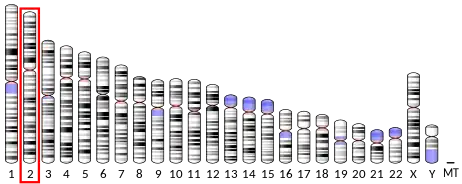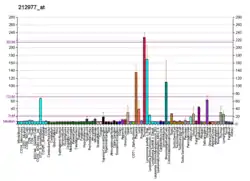Atypical chemokine receptor 3 also known as C-X-C chemokine receptor type 7 (CXCR-7) and G-protein coupled receptor 159 (GPR159) is a protein that in humans is encoded by the ACKR3 gene.[5][6]
This gene encodes a G protein-coupled receptor family member. It belongs to the chemokine receptor family of GPCRs. Within this family, ACKR3 is classified as a class A GPCR.[7] This GPCR protein was earlier thought to be a receptor for vasoactive intestinal peptide (VIP) and was considered to be an orphan receptor. It is now classified as a chemokine receptor able to bind the chemokines CXCL12/SDF-1 and CXCL11. The protein is also a coreceptor for human immunodeficiency viruses (HIV). Translocations involving this gene and HMGA2 on chromosome 12 have been observed in lipomas. Alternatively spliced transcript variants encoding the same protein isoform have been found for this gene. Whereas some reports claim that the receptor induces signaling following ligand binding, recent findings in zebrafish suggest that CXCR7 functions primarily by sequestering the chemokine CXCL12.[6]
Another study has provided evidence that ligand binding to CXCR7 activates MAP kinases through Beta-arrestins, and thus has functions beyond ligand sequestration.[8]
ACKR3 has also been shown to sequester endogenous opioid peptides, and is thought to modulate their activity. Inhibition of ACKR3 by ligands such as the peptide LIH383 (FGGFMRRK-NH2) increases opioid peptide activity and produces analgesic and antidepressant effects in animal studies.[9]
Nomenclature
In 2013, the Nomenclature and Standards Committee of the International Union of Basic and Clinical Pharmacology subcommittee for chemokine receptors reevaluated C-X-C chemokine receptor type 7 (CXCR7) and classified it as an atypical chemokine receptor, leading to its renaming as atypical chemokine receptor 3 (ACKR3). Additional names that have been mentioned in the literature, albeit less frequently, include GPR159 and Orphan receptor RDC1, the latter being a term primarily found in older literature.[10]
Function
ACKR3 stands out as an atypical receptor due to its β-arrestin-biased signaling nature. In the case of a β-arrestin-biased receptor like ACKR3, when it is treated with an unbiased ligand, it triggers signaling pathways solely mediated by β-arrestin. What sets ACKR3 apart is its absence of G-protein involvement, which distinguishes it from typical GPCRs.[11]
Despite being considered atypical, the functions of ACKR3 do not imply that it acts as a completely inactive receptor for CXCL12. On the contrary, extensive literature supports the notion of ACKR3 engaging in active signaling, which is believed to rely on arrestin-mediated mechanisms. Nevertheless, its role as a decoy receptor for CXCL12/SDF1 is well-established. This is evident by the significantly higher affinity of CXCL12 binding to ACKR3/CXCR7 compared to CXCR4, along with its constant internalization facilitated by the recruitment of β-arrestin, without known downstream signaling events.[12][13]
In addition to CXCL12, ACKR3 engages with multiple ligands, encompassing CXCL11, macrophage inhibitory factor (MIF), adrenomedullin (ADM), opioid peptides such as nociceptin, dynorphin, and enkephalin, as well as the viral chemokine vCCL2/viral macrophage inflammatory protein-II. [12][14]
Interactions
ACKR3 and CXCR4 have been shown to interact, different possibilities regarding the involvement of ACKR3 and CXCR4 in CXCL12 signaling:[12]
A) ACKR3 can attenuate CXCR4 signaling by forming heterodimers with CXCR4. While this interaction was initially observed in cells with CXCR7 overexpression, it has rarely been observed with endogenous CXCR7.
B) Multiple cell types demonstrate that either ACKR3 or CXCR4 controls specific cell functions (e.g., migration, proliferation). The distinct regulation of these functions occurs through one of the receptors.
C) Synergistic effects between CXCR4 and ACKR3 have been observed in many cases, suggesting that cellular responses to CXCL12 require the presence of both receptors. Whether receptor heterodimerization is responsible for these synergistic effects remains uncertain.
D) In addition to synergistic effects, a few studies have shown additive effects of ACKR3 and CXCR4 on specific cell functions. However, it has not been experimentally tested whether receptor heterodimerization is necessary for these additive effects. E) Within specific cell types, CXCR4, ACKR3, and CXCR4/ACKR3 heterodimers control distinct cell functions. This pattern appears to be a common arrangement of the CXCL12 system in various types of stem and progenitor cells.
References
- 1 2 3 GRCh38: Ensembl release 89: ENSG00000144476 - Ensembl, May 2017
- 1 2 3 GRCm38: Ensembl release 89: ENSMUSG00000044337 - Ensembl, May 2017
- ↑ "Human PubMed Reference:". National Center for Biotechnology Information, U.S. National Library of Medicine.
- ↑ "Mouse PubMed Reference:". National Center for Biotechnology Information, U.S. National Library of Medicine.
- ↑ Balabanian K, Lagane B, Infantino S, Chow KY, Harriague J, Moepps B, et al. (October 2005). "The chemokine SDF-1/CXCL12 binds to and signals through the orphan receptor RDC1 in T lymphocytes". The Journal of Biological Chemistry. 280 (42): 35760–35766. doi:10.1074/jbc.M508234200. PMID 16107333.
- 1 2 "Entrez Gene: CXCR7 chemokine (C-X-C motif) receptor 7".
- ↑ Fumagalli A, Zarca A, Neves M, Caspar B, Hill SJ, Mayor F, et al. (December 2019). "CXCR4/ACKR3 Phosphorylation and Recruitment of Interacting Proteins: Key Mechanisms Regulating Their Functional Status". Molecular Pharmacology. 96 (6): 794–808. doi:10.1124/mol.118.115360. hdl:10261/214032. PMID 30837297. S2CID 73513931.
- ↑
- Rajagopal S, Kim J, Ahn S, Craig S, Lam CM, Gerard NP, et al. (January 2010). "Beta-arrestin- but not G protein-mediated signaling by the "decoy" receptor CXCR7". Proceedings of the National Academy of Sciences of the United States of America. 107 (2): 628–632. Bibcode:2010PNAS..107..628R. doi:10.1073/pnas.0912852107. PMC 2818968. PMID 20018651.
- ↑ Meyrath M, Szpakowska M, Zeiner J, Massotte L, Merz MP, Benkel T, et al. (June 2020). "The atypical chemokine receptor ACKR3/CXCR7 is a broad-spectrum scavenger for opioid peptides". Nature Communications. 11 (1): 3033. Bibcode:2020NatCo..11.3033M. doi:10.1038/s41467-020-16664-0. PMC 7305236. PMID 32561830.
- ↑ Bachelerie F, Graham GJ, Locati M, Mantovani A, Murphy PM, Nibbs R, et al. (March 2014). "New nomenclature for atypical chemokine receptors". Nature Immunology. 15 (3): 207–208. doi:10.1038/ni.2812. PMID 24549061. S2CID 205367583.
- ↑ Rajagopal S, Kim J, Ahn S, Craig S, Lam CM, Gerard NP, et al. (January 2010). "Beta-arrestin- but not G protein-mediated signaling by the "decoy" receptor CXCR7". Proceedings of the National Academy of Sciences of the United States of America. 107 (2): 628–632. Bibcode:2010PNAS..107..628R. doi:10.1073/pnas.0912852107. PMC 2818968. PMID 20018651.
- 1 2 3 Koch C, Engele J (November 2020). "Functions of the CXCL12 Receptor ACKR3/CXCR7-What Has Been Perceived and What Has Been Overlooked". Molecular Pharmacology. 98 (5): 577–585. doi:10.1124/molpharm.120.000056. PMID 32883765. S2CID 221498026.
- ↑ Pance K, Gramespacher JA, Byrnes JR, Salangsang F, Serrano JC, Cotton AD, et al. (February 2023). "Modular cytokine receptor-targeting chimeras for targeted degradation of cell surface and extracellular proteins". Nature Biotechnology. 41 (2): 273–281. doi:10.1038/s41587-022-01456-2. PMC 9931583. PMID 36138170.
- ↑ Meyrath M, Szpakowska M, Zeiner J, Massotte L, Merz MP, Benkel T, et al. (June 2020). "The atypical chemokine receptor ACKR3/CXCR7 is a broad-spectrum scavenger for opioid peptides". Nature Communications. 11 (1): 3033. Bibcode:2020NatCo..11.3033M. doi:10.1038/s41467-020-16664-0. PMC 7305236. PMID 32561830.
External links
- Human ACKR3 genome location and ACKR3 gene details page in the UCSC Genome Browser.
Further reading
- Nagata S, Ishihara T, Robberecht P, Libert F, Parmentier M, Christophe J, Vassart G (March 1992). "RDC1 may not be VIP receptor". Trends in Pharmacological Sciences. 13 (3): 102–103. doi:10.1016/0165-6147(92)90037-7. PMID 1315461.
- Libert F, Passage E, Parmentier M, Simons MJ, Vassart G, Mattei MG (September 1991). "Chromosomal mapping of A1 and A2 adenosine receptors, VIP receptor, and a new subtype of serotonin receptor". Genomics. 11 (1): 225–227. doi:10.1016/0888-7543(91)90125-X. PMID 1662665.
- Sreedharan SP, Robichon A, Peterson KE, Goetzl EJ (June 1991). "Cloning and expression of the human vasoactive intestinal peptide receptor". Proceedings of the National Academy of Sciences of the United States of America. 88 (11): 4986–4990. Bibcode:1991PNAS...88.4986S. doi:10.1073/pnas.88.11.4986. PMC 51792. PMID 1675791.
- Law NM, Rosenzweig SA (May 1994). "Characterization of the G-protein linked orphan receptor GPRN1/RDC1". Biochemical and Biophysical Research Communications. 201 (1): 458–465. doi:10.1006/bbrc.1994.1723. PMID 8198609.
- Shimizu N, Soda Y, Kanbe K, Liu HY, Mukai R, Kitamura T, Hoshino H (January 2000). "A putative G protein-coupled receptor, RDC1, is a novel coreceptor for human and simian immunodeficiency viruses". Journal of Virology. 74 (2): 619–626. doi:10.1128/JVI.74.2.619-626.2000. PMC 111581. PMID 10623723.
- Broberg K, Zhang M, Strömbeck B, Isaksson M, Nilsson M, Mertens F, et al. (August 2002). "Fusion of RDC1 with HMGA2 in lipomas as the result of chromosome aberrations involving 2q35-37 and 12q13-15". International Journal of Oncology. 21 (2): 321–326. doi:10.3892/ijo.21.2.321. PMID 12118328.
- Infantino S, Moepps B, Thelen M (February 2006). "Expression and regulation of the orphan receptor RDC1 and its putative ligand in human dendritic and B cells". Journal of Immunology. 176 (4): 2197–2207. doi:10.4049/jimmunol.176.4.2197. PMID 16455976.
- Burns JM, Summers BC, Wang Y, Melikian A, Berahovich R, Miao Z, et al. (September 2006). "A novel chemokine receptor for SDF-1 and I-TAC involved in cell survival, cell adhesion, and tumor development". The Journal of Experimental Medicine. 203 (9): 2201–2213. doi:10.1084/jem.20052144. PMC 2118398. PMID 16940167.
- Proost P, Mortier A, Loos T, Vandercappellen J, Gouwy M, Ronsse I, et al. (July 2007). "Proteolytic processing of CXCL11 by CD13/aminopeptidase N impairs CXCR3 and CXCR7 binding and signaling and reduces lymphocyte and endothelial cell migration". Blood. 110 (1): 37–44. doi:10.1182/blood-2006-10-049072. PMID 17363734.
- Miao Z, Luker KE, Summers BC, Berahovich R, Bhojani MS, Rehemtulla A, et al. (October 2007). "CXCR7 (RDC1) promotes breast and lung tumor growth in vivo and is expressed on tumor-associated vasculature". Proceedings of the National Academy of Sciences of the United States of America. 104 (40): 15735–15740. Bibcode:2007PNAS..10415735M. doi:10.1073/pnas.0610444104. PMC 1994579. PMID 17898181.
- Wang J, Shiozawa Y, Wang J, Wang Y, Jung Y, Pienta KJ, et al. (February 2008). "The role of CXCR7/RDC1 as a chemokine receptor for CXCL12/SDF-1 in prostate cancer". The Journal of Biological Chemistry. 283 (7): 4283–4294. doi:10.1074/jbc.M707465200. PMID 18057003.
- Boldajipour B, Mahabaleshwar H, Kardash E, Reichman-Fried M, Blaser H, Minina S, et al. (February 2008). "Control of chemokine-guided cell migration by ligand sequestration". Cell. 132 (3): 463–473. doi:10.1016/j.cell.2007.12.034. hdl:11858/00-001M-0000-0012-DDE5-7. PMID 18267076.
- Takaya K, Asou T, Kishi K (June 2022). "Selective Elimination of Senescent Fibroblasts by Targeting the Cell Surface Protein ACKR3". International Journal of Molecular Sciences. 23 (12): 6531. doi:10.3390/ijms23126531. PMC 9223754. PMID 35742971.
This article incorporates text from the United States National Library of Medicine, which is in the public domain.




